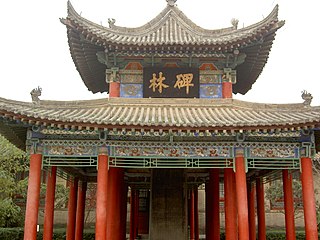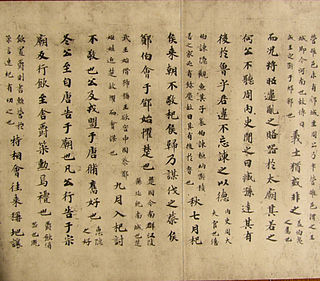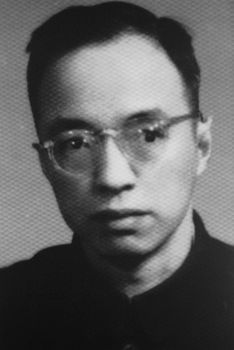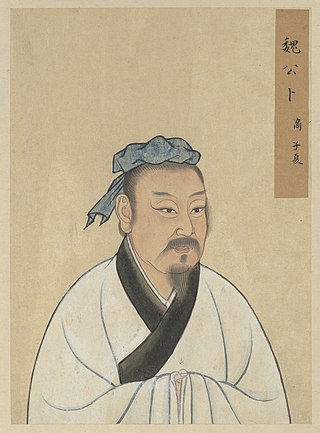The Chinese classics or canonical texts are the works of Chinese literature authored prior to the establishment of the imperial Qin dynasty in 221 BC. Prominent examples include the Four Books and Five Classics in the Neo-Confucian tradition, themselves an abridgment of the Thirteen Classics. The Chinese classics used a form of written Chinese consciously imitated by later authors, now known as Classical Chinese. A common Chinese word for "classic" literally means 'warp thread', in reference to the techniques by which works of this period were bound into volumes.

The Zuo Zhuan, often translated The Zuo Tradition or The Commentary of Zuo, is an ancient Chinese narrative history that is traditionally regarded as a commentary on the ancient Chinese chronicle Spring and Autumn Annals. It comprises 30 chapters covering a period from 722 to 468 BC, and focuses mainly on political, diplomatic, and military affairs from that era.

Zuo Qiuming, Zuoqiu Ming or Qiu Ming was a Chinese historian who was a contemporary of Confucius. He lived in the State of Lu during the Spring and Autumn period. He was a historian, litterateur, thinker and essayist who worked as a Lu official.
In Chinese philology, the Ancient Script Classics refer to some versions of the Five Classics discovered during the Han dynasty, written in a script that predated the one in use during the Han dynasty, and produced before the burning of the books. The term became used in contrast with "Current Script Classics" (今文經), which indicated a group of texts written in the orthography currently in use during the Han dynasty.

The Kaicheng Stone Classics (開成石經) or Tang Stone Classics are a group of twelve early Chinese classic works carved on the orders of Emperor Wenzong of the Tang dynasty in 833–837 as a reference document for scholars. The works recorded are:
Duke Cheng of Lu was the 21st ruler of the state of Lu during the Spring and Autumn period. A son of Duke Xuan of Lu (鲁宣公) and Mu Jiang, he reigned for 18 years from 590 BC to 573 BC. His name was Heigong (黑肱), which means "black arm". He was described as a weak ruler under the influence of his mother.
The Thirteen Classics is a term for the group of thirteen classics of Confucian tradition that became the basis for the Imperial Examinations during the Song dynasty and have shaped much of East Asian culture and thought. It includes all of the Four Books and Five Classics but organizes them differently and includes the Classic of Filial Piety and Erya.

The State of Shen was a Chinese vassal state during the Zhou dynasty ruled by the Jiāng family (姜) as an earldom. At the beginning of the Spring and Autumn period the State of Shen was annexed by the State of Chu and became one of its counties.
The Gongyang Zhuan, also known as the Gongyang Commentary on the Spring and Autumn Annals or the Commentary of Gongyang, is a commentary on the Spring and Autumn Annals, and is thus one of the Chinese classics. Along with the Zuo Zhuan and the Guliang Zhuan, the work is one of the Three Commentaries on the Spring and Autumn Annals. In particular, Gongyang Zhuan is a central work to New Text Confucianism (今文經學), which advocates Confucius as an institutional reformer instead of a respected scholar, and Chunqiu as an embodiment of Confucius' holistic vision on political, social, and moral issues instead of a merely chronicle. Gongyang Zhuan significantly influenced the political institution in Han dynasty. It fell out of favor among elites and was eventually replaced by the Zuo Zhuan. Gongyang Zhuan scholarship was reinvigorated in late Ming dynasty and became a major source of inspiration for Chinese reformers from eighteen to early twentieth century.

The Spring and Autumn Annals is an ancient Chinese chronicle that has been one of the core Chinese classics since ancient times. The Annals is the official chronicle of the State of Lu, and covers a 241-year period from 722 to 481 BC. It is the earliest surviving Chinese historical text to be arranged in annals form. Because it was traditionally regarded as having been compiled by Confucius—after a claim to this effect by Mencius—it was included as one of the Five Classics of Chinese literature.
Dai Sheng, also known as Xiao Dai,, birth and death unknown, was the Scholar of Rituals to Emperor Xuan of the Former Han dynasty. He was the son of Dai Ren (戴仁) and the nephew of Dai De. He was a native of Liang and a founder of the Former Han dynasty Jinwen Jingxue.
Dai De, also known as Da Dai,, birth and death unknown, was a Confucian scholar of the western Han Dynasty. He was active during the reign of Emperor Xuan of Han and then Emperor Yuan of Han.

The Battle of An was fought during the Spring and Autumn period in 589 BC at Hua Hill in the area of the present-day city of Jinan, Shandong between the states of Qi and Jin. It ended in a victory for the state of Jin and eventually resulted in an alliance between the two states.

The Study of Current Script Texts is a school of thought in Confucianism that was based on Confucian classics recompiled in the early Han dynasty by Confucians who survived the burning of books and burying of scholars during the Qin dynasty. The survivors wrote the classics in the contemporary characters of their time, and these texts were later dubbed as "Current Script" 今文. Current Script school attained prominence in the Western Han dynasty and became the official interpretation for Confucianism, which was adopted as the official ideology by Emperor Wu of Han.

Yang Bojun was a Chinese philologist best known for his Chunqiu Zuozhuan Zhu (春秋左传注), an annotated commentary of the ancient Chinese historical text and Confucian classic Zuo Zhuan. The work took him more than twenty years to finish. His commentaries of the Analects of Confucius and the Mencius are also highly influential.

Bu Shang, commonly known by his courtesy name Zixia or as Buzi, was an ancient Chinese philosopher and a prominent disciple of Confucius who was considered one of the most accomplished in cultural learning. He was one of the five disciples who took chief responsibility for the transmission of Confucius' teachings. He played a significant role in the transmission of such classics as the Book of Poetry and the I Ching. He established his own school, and taught Marquess Wen of Wei, ruler of Wei, the most powerful state of the early Warring States period.
Jia Kui, courtesy name Jingbo, was a Confucian philosopher who lived in the early Eastern Han period. He was a descendant of the Western Han politician and writer Jia Yi. He was born in Pingling (平陵), Youfufeng Commandery (右扶風郡), which is located northeast of present-day Xingping, Shaanxi. He studied at university in Luoyang.
Ziban was the 17th ruler of the State of Lu during the Spring and Autumn period of ancient China. His ancestral name was Ji (姬), and given name Ban (般). He appears in history as Ziban due to his reign being less than a year long, as Ziban died in the same year as his father, Duke Zhuang of Lu.
Duke Wen of Lu was the ruler of Lu from 626 BC to 609 BC in Spring and Autumn period. His ancestral name was Ji (姬), given name Shen (興), and Wen (文) his posthumous name. His father was Duke Xi of Lu.
Duke Yin of Lu was from 722 to 712 BC the 14th ruler of the State of Lu during the Spring and Autumn period of ancient China. His ancestral name was Ji (姬), given name Xigu (息姑), and Duke Yin was his posthumous title. He is notable in Chinese history as being the first ruler of Lu whose reign was recorded by the Spring and Autumn Annals and, by extension, its commentaries such as the Zuo Zhuan, the Gongyang Zhuan, and the Guliang Zhuan.









